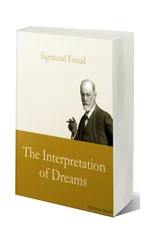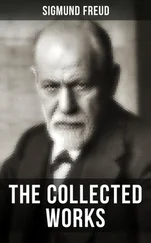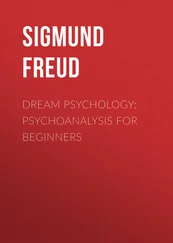Sigmund Freud - Dream Psychology
Здесь есть возможность читать онлайн «Sigmund Freud - Dream Psychology» весь текст электронной книги совершенно бесплатно (целиком полную версию без сокращений). В некоторых случаях можно слушать аудио, скачать через торрент в формате fb2 и присутствует краткое содержание. Год выпуска: 2014, Издательство: epubBooks Classics, Жанр: Психология, на английском языке. Описание произведения, (предисловие) а так же отзывы посетителей доступны на портале библиотеки ЛибКат.
- Название:Dream Psychology
- Автор:
- Издательство:epubBooks Classics
- Жанр:
- Год:2014
- ISBN:нет данных
- Рейтинг книги:3 / 5. Голосов: 1
-
Избранное:Добавить в избранное
- Отзывы:
-
Ваша оценка:
- 60
- 1
- 2
- 3
- 4
- 5
Dream Psychology: краткое содержание, описание и аннотация
Предлагаем к чтению аннотацию, описание, краткое содержание или предисловие (зависит от того, что написал сам автор книги «Dream Psychology»). Если вы не нашли необходимую информацию о книге — напишите в комментариях, мы постараемся отыскать её.
Dream Psychology — читать онлайн бесплатно полную книгу (весь текст) целиком
Ниже представлен текст книги, разбитый по страницам. Система сохранения места последней прочитанной страницы, позволяет с удобством читать онлайн бесплатно книгу «Dream Psychology», без необходимости каждый раз заново искать на чём Вы остановились. Поставьте закладку, и сможете в любой момент перейти на страницу, на которой закончили чтение.
Интервал:
Закладка:
Another manifestation of the dream work which all incoherent dreams have in common is still more noticeable. Choose any instance, and compare the number of separate elements in it, or the extent of the dream, if written down, with the dream thoughts yielded by analysis, and of which but a trace can be refound in the dream itself. There can be no doubt that the dream working has resulted in an extraordinary compression or condensation . It is not at first easy to form an opinion as to the extent of the condensation; the more deeply you go into the analysis, the more deeply you are impressed by it. There will be found no factor in the dream whence the chains of associations do not lead in two or more directions, no scene which has not been pieced together out of two or more impressions and events. For instance, I once dreamt about a kind of swimming–bath where the bathers suddenly separated in all directions; at one place on the edge a person stood bending towards one of the bathers as if to drag him out. The scene was a composite one, made up out of an event that occurred at the time of puberty, and of two pictures, one of which I had seen just shortly before the dream. The two pictures were The Surprise in the Bath, from Schwind's Cycle of the Melusine (note the bathers suddenly separating), and The Flood, by an Italian master. The little incident was that I once witnessed a lady, who had tarried in the swimming–bath until the men's hour, being helped out of the water by the swimming–master. The scene in the dream which was selected for analysis led to a whole group of reminiscences, each one of which had contributed to the dream content. First of all came the little episode from the time of my courting, of which I have already spoken; the pressure of a hand under the table gave rise in the dream to the "under the table," which I had subsequently to find a place for in my recollection. There was, of course, at the time not a word about "undivided attention." Analysis taught me that this factor is the realization of a desire through its contradictory and related to the behavior of my wife at the table d'hôte. An exactly similar and much more important episode of our courtship, one which separated us for an entire day, lies hidden behind this recent recollection. The intimacy, the hand resting upon the knee, refers to a quite different connection and to quite other persons. This element in the dream becomes again the starting–point of two distinct series of reminiscences, and so on.
The stuff of the dream thoughts which has been accumulated for the formation of the dream scene must be naturally fit for this application. There must be one or more common factors. The dream work proceeds like Francis Galton with his family photographs. The different elements are put one on top of the other; what is common to the composite picture stands out clearly, the opposing details cancel each other. This process of reproduction partly explains the wavering statements, of a peculiar vagueness, in so many elements of the dream. For the interpretation of dreams this rule holds good: When analysis discloses uncertainty , as to either — or read and , taking each section of the apparent alternatives as a separate outlet for a series of impressions.
When there is nothing in common between the dream thoughts, the dream work takes the trouble to create a something, in order to make a common presentation feasible in the dream. The simplest way to approximate two dream thoughts, which have as yet nothing in common, consists in making such a change in the actual expression of one idea as will meet a slight responsive recasting in the form of the other idea. The process is analogous to that of rhyme, when consonance supplies the desired common factor. A good deal of the dream work consists in the creation of those frequently very witty, but often exaggerated, digressions. These vary from the common presentation in the dream content to dream thoughts which are as varied as are the causes in form and essence which give rise to them. In the analysis of our example of a dream, I find a like case of the transformation of a thought in order that it might agree with another essentially foreign one. In following out the analysis I struck upon the thought: I should like to have something for nothing . But this formula is not serviceable to the dream. Hence it is replaced by another one: "I should like to enjoy something free of cost." [1] "Ich möchte gerne etwas geniessen ohne 'Kosten' zu haben." A a pun upon the word "kosten," which has two meanings—"taste" and "cost." In "Die Traumdeutung," third edition, p. 71 footnote, Professor Freud remarks that "the finest example of dream interpretation left us by the ancients is based upon a pun" (from "The Interpretation of Dreams," by Artemidorus Daldianus). "Moreover, dreams are so intimately bound up with language that Ferenczi truly points out that every tongue has its own language of dreams. A dream is as a rule untranslatable into other languages."—TRANSLATOR.
The word "kost" (taste), with its double meaning, is appropriate to a table d'hôte; it, moreover, is in place through the special sense in the dream. At home if there is a dish which the children decline, their mother first tries gentle persuasion, with a "Just taste it." That the dream work should unhesitatingly use the double meaning of the word is certainly remarkable; ample experience has shown, however, that the occurrence is quite usual.
Through condensation of the dream certain constituent parts of its content are explicable which are peculiar to the dream life alone, and which are not found in the waking state. Such are the composite and mixed persons, the extraordinary mixed figures, creations comparable with the fantastic animal compositions of Orientals; a moment's thought and these are reduced to unity, whilst the fancies of the dream are ever formed anew in an inexhaustible profusion. Every one knows such images in his own dreams; manifold are their origins. I can build up a person by borrowing one feature from one person and one from another, or by giving to the form of one the name of another in my dream. I can also visualize one person, but place him in a position which has occurred to another. There is a meaning in all these cases when different persons are amalgamated into one substitute. Such cases denote an "and," a "just like," a comparison of the original person from a certain point of view, a comparison which can be also realized in the dream itself. As a rule, however, the identity of the blended persons is only discoverable by analysis, and is only indicated in the dream content by the formation of the "combined" person.
The same diversity in their ways of formation and the same rules for its solution hold good also for the innumerable medley of dream contents, examples of which I need scarcely adduce. Their strangeness quite disappears when we resolve not to place them on a level with the objects of perception as known to us when awake, but to remember that they represent the art of dream condensation by an exclusion of unnecessary detail. Prominence is given to the common character of the combination. Analysis must also generally supply the common features. The dream says simply: All these things have an "x" in common . The decomposition of these mixed images by analysis is often the quickest way to an interpretation of the dream. Thus I once dreamt that I was sitting with one of my former university tutors on a bench, which was undergoing a rapid continuous movement amidst other benches. This was a combination of lecture–room and moving staircase. I will not pursue the further result of the thought. Another time I was sitting in a carriage, and on my lap an object in shape like a top–hat, which, however, was made of transparent glass. The scene at once brought to my mind the proverb: "He who keeps his hat in his hand will travel safely through the land." By a slight turn the glass hat reminded me of Auer's light , and I knew that I was about to invent something which was to make me as rich and independent as his invention had made my countryman, Dr. Auer, of Welsbach; then I should be able to travel instead of remaining in Vienna. In the dream I was traveling with my invention, with the, it is true, rather awkward glass top–hat. The dream work is peculiarly adept at representing two contradictory conceptions by means of the same mixed image. Thus, for instance, a woman dreamt of herself carrying a tall flower–stalk, as in the picture of the Annunciation (Chastity–Mary is her own name), but the stalk was bedecked with thick white blossoms resembling camellias (contrast with chastity: La dame aux Camelias).
Читать дальшеИнтервал:
Закладка:
Похожие книги на «Dream Psychology»
Представляем Вашему вниманию похожие книги на «Dream Psychology» списком для выбора. Мы отобрали схожую по названию и смыслу литературу в надежде предоставить читателям больше вариантов отыскать новые, интересные, ещё непрочитанные произведения.
Обсуждение, отзывы о книге «Dream Psychology» и просто собственные мнения читателей. Оставьте ваши комментарии, напишите, что Вы думаете о произведении, его смысле или главных героях. Укажите что конкретно понравилось, а что нет, и почему Вы так считаете.












